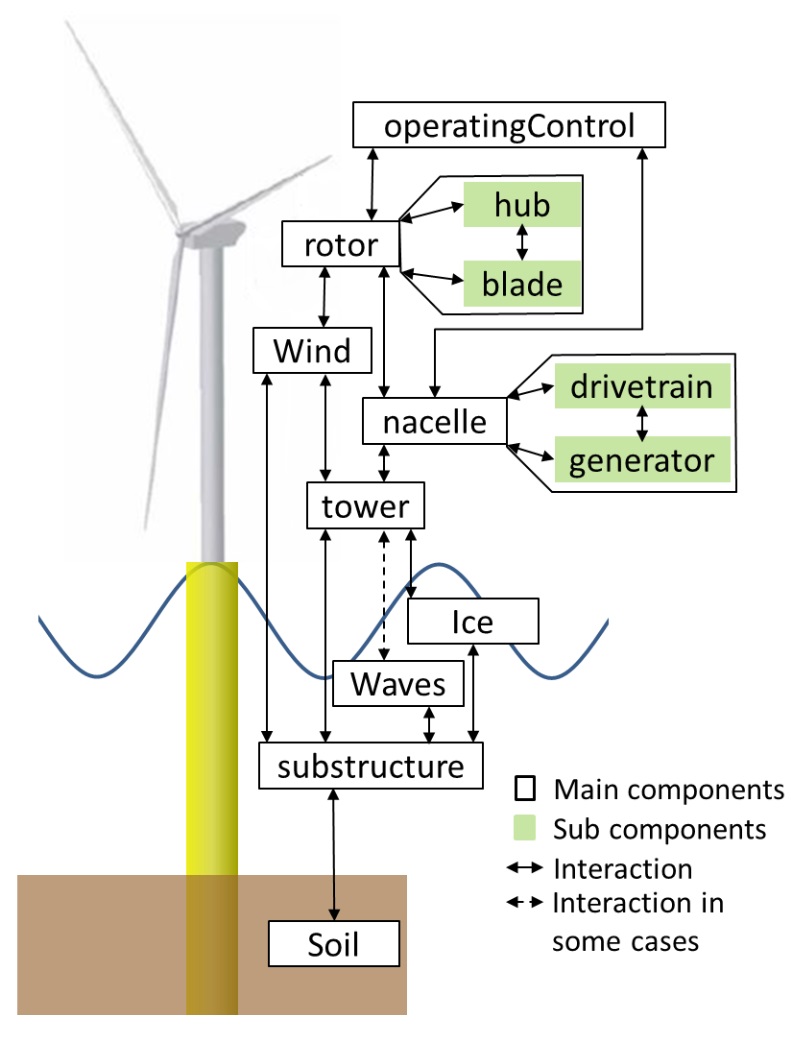Offshore Conditions: Hydrodynamics and Ice Loads
In addition to aerodynamic loads on the wind turbine, the offshore environment also implies hydrodynamic and ice loads on the offshore wind turbine system.
With respect to hydrodynamic loads, wave excitation, buoyancy force, and current impact have to be considered. The general approach for determining wave loads on a structure is to use the Morison equation. A more sophisticated approach, which also accounts for diffraction and radiation effects, is the MacCamy-Fuchs approach. The buoyancy force and righting moment are calculated depending on the wave surface elevation at the specific location and time, as well as the current position of a floating wind turbine system. Three different current types can be distinguished according to standards (IEC 61400-3) for determination of the current impact on the structure:
- sub-surface currents, which are generated by tides, storm surge, or atmospheric pressure variations;
- wind-generated, near-surface currents, which are no longer present more than 20 m below the still water level;
- near-shore, wave-induced surface currents, which run parallel to the coastline and cause shear forces due to the breaking waves.
The impact of sea ice loads on the global dynamics of Offshore Wind Turbines (OWTs) is being investigated at Fraunhofer IWES. The research environment, industry, and certification authorities are currently lacking an understanding of this aspect. Thus far, they all have been relying on the ice experts (with little or no background in turbine dynamics), whose methods for ice-load calculation are not fully transparent and not always compatible with design and certification methodologies for OWTs. Fraunhofer IWES cooperates in the field of sea ice with RAMBOLL, TUHH within the SeaLOWT project, and also external experts from NTNU and TU Delft.
Control for Automated Load Calculation
The Fraunhofer IWES baseline controller was designed and implemented in order to support the load simulation. The controller is programmed in Fortran 90 using the external DLL interface convention defined by DNV-GL Bladed 4.3. The baseline controller features both collective pitch control and individual pitch control capabilities including both partial- and full-loading operation modes. Three load reduction methods, namely active drivetrain damping, tower fore-aft and side-to-side damping, are used. The basic supervisory control procedures including normal stop, emergency stop, overspeed monitor, and grid loss are implemented.
Applied Load Calculation in Industry and Research Projects
An excerpt for applied load calculation in industry projects:
- analysis of relevant tower movements for an onshore wind turbine
- control development for load reduction for an onshore wind turbine
- training in requirements for load analysis
- assessment of the sea ice loads for offshore wind turbines
- load assessment for a floating offshore prototype
An excerpt for applied load calculation in research projects:
- load analysis for the design of a 20 m and an 80 m rotor blade
- comparison of different active/passive load reduction strategies for rotor blades
- load analysis for the design of monopiles for different North Sea sites
- reliability-based optimization of floating wind turbine support structures
- validation of tools for load analysis of wind turbines
- assessment of wind turbine loading from wind fields with non-Gaussian wind increment statistics


